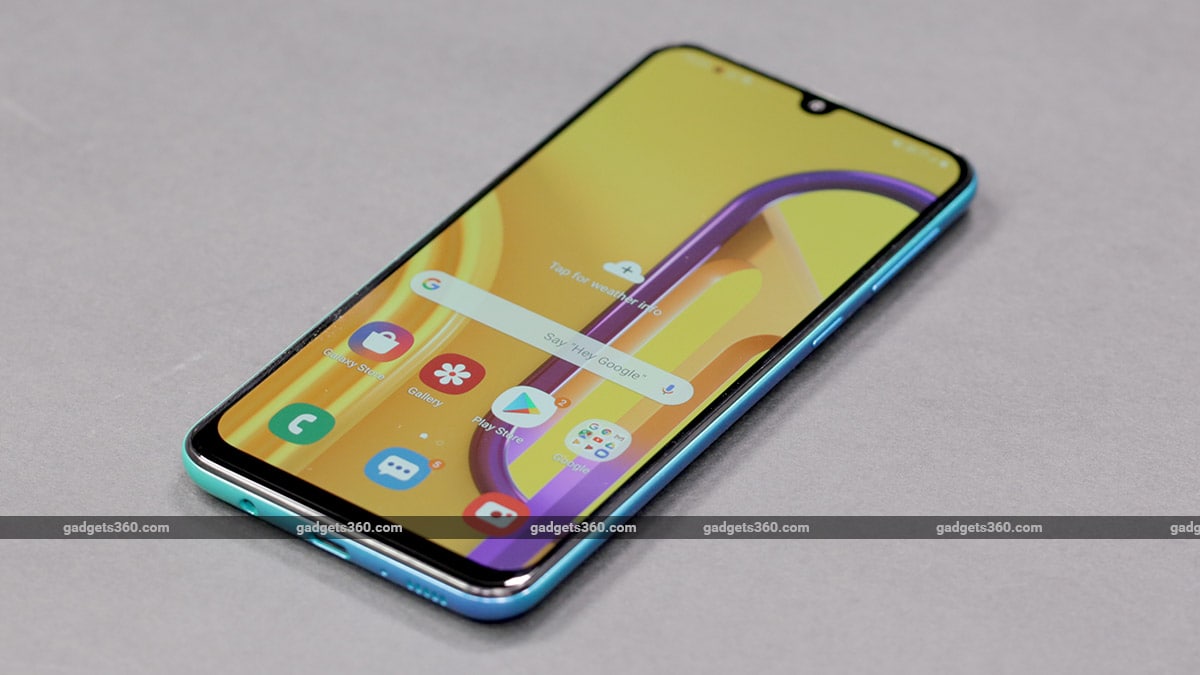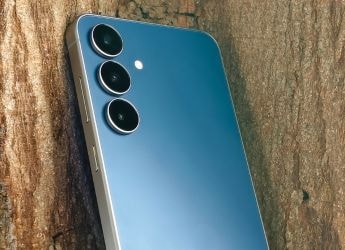- Home
- Mobiles
- Mobiles Reviews
- Samsung Galaxy M30s Review
Samsung Galaxy M30s Review
The phone with a massive 6,000mAh battery.

Big battery, longer battery life
Samsung launched the Galaxy M series at the beginning of this year to strengthen its position against Chinese competition. The sub-Rs. 20,000 segment was dominated by multiple models from the likes of Xiaomi and Honor, many of which offered better value for money than the devices that Samsung was selling at the time. As a result, the Galaxy M series was launched with a strong focus on the online market.
The Samsung Galaxy M30 (Review) was one of the most high-profile models in this series when it launched at around the Rs 15,000 mark. This smartphone sported an AMOLED display and offered good battery life. Samsung has now launched an updated version of this smartphone dubbed the Galaxy M30s. Does it improve on the M30's strengths and fix its weaknesses? We put the Samsung Galaxy M30s to the test to find out.
Samsung Galaxy M30s design
Most Samsung smartphones in the Galaxy M series sport similar designs on the front, with the Galaxy M40 (Review) being the exception thanks to its hole-punch display. The Galaxy M30s sports a 6.4-inch full-HD+ AMOLED display with a dewdrop notch at the top, which Samsung calls the Infinity-U display. The panel has thin bezels on the sides, though the chin is thicker. Samsung has pushed the earpiece towards the frame of the smartphone and it sits just above the selfie camera. While the earpiece is small, we did not have any issues hearing our callers on this device.
Samsung has positioned the power and volume buttons on the right side of the device. We found the power button to be well-positioned but the volume buttons require you to stretch your fingers. At the top, the Galaxy M30s only has a secondary microphone, while the USB Type-C port, 3.5mm headphone jack, primary microphone, and loudspeaker are on the bottom. Samsung has put the SIM tray on the left side.
![]() The crisp AMOLED display on the Samsung Galaxy M30s makes colours pop
The crisp AMOLED display on the Samsung Galaxy M30s makes colours pop
The Samsung Galaxy M30s sports a triple camera setup at the back which is placed in a rectangular camera module. The fingerprint scanner is also at the back, next to the camera module, and it is easy to reach. Samsung offers the M30s in three colour variants: Opal Black, Sapphire Blue, and Pearl White. We had the Sapphire Blue version in for review, which has a gradient finish at the back. This looks a little different, and we like it, though this may not be the case for everyone. You can opt for the more traditional Black or White colour options instead.
Samsung has fitted a massive 6,000mAh battery into the M30s, which is bigger than the one its predecessor, the M30 had. This phone is rather bulky but since the back is curved it is manageable in the hand. Samsung ships a 15W charger in the box.
Samsung Galaxy M30s specifications and software
The Samsung Galaxy M30s sports a 6.4-inch full-HD+ AMOLED display with a resolution of 1080x2340 pixels. There are two colour modes to choose from, and the phone is set to Natural by default. We changed the display mode to Vivid which boosted the contrast and looked more pleasant to our eyes. There is no way to adjust the colour temperature of the display but we were happy with the default setting.
Samsung has picked its own Exynos 9611 SoC for the Galaxy M30s, this is the same processor the company has used for the recently launched Galaxy A50s (Review) as well. This SoC has four performance ARM Cortex-A73 cores clocked at 2.3GHz and four efficiency Cortex-A53 cores clocked at 1.7GHz. It also features integrated Mali-G72 graphics. The smartphone is available in two variants: 4GB of RAM with 64GB of storage, and 6GB of RAM with 128GB of storage, and we had the latter for this review. The base variant of the device is priced at Rs. 13,990 while the higher-end one is priced at Rs. 16,999.
![]() The gradient finish on the back of the Samsung Galaxy M30s looks good but it may not be to everyone's taste
The gradient finish on the back of the Samsung Galaxy M30s looks good but it may not be to everyone's taste
The Samsung Galaxy M30s is a dual-SIM device and has two Nano-SIM slots. There is support for dual 4G as well as VoLTE, Bluetooth 5, Wi-Fi 802.11ac, and the usual sensors.
Samsung ships the Galaxy M30s with One UI 1.5 on top of Android 9 Pie, and our unit was running the August security patch. We have used the same UI on several of the Samsung Galaxy smartphones that we have tested. This UI is designed with reachability in mind, and so most system apps and menus can be pulled down so that tappable areas are within reach, making single-handed use easier.
Digital Wellbeing, a popular Android Pie feature, is available along with the Wind Down mode which switches the screen to grayscale and sets the phone to DND to help you unwind. There are a few other features such as Dual Messenger which lets you run two instances of supported apps. Samsung puts the Super AMOLED panel to use by offering an always-on display option. This lets you glance over notifications and other alerts on the lockscreen (along with the time) when the device is locked.
The smartphone has some bloatware, most of which can only be disabled. Preinstalled apps include Facebook, Netflix, Galaxy Store, OneDrive, and My Galaxy. We found the My Galaxy app to be the most spammy of the lot, and had to block all its notifications. The Lock Screen Stories option dynamically changes the lock screen wallpaper on the smartphone.
Samsung Galaxy M30s performance and battery life
The Samsung Galaxy M30s has a good display, and watching content on it was a pleasant experience. It gets bright enough outdoors and we did not have issues with sunlight legibility. The Exynos 9611 powering the smartphone is capable of delivering a smooth experience without any hiccups. We could navigate through the menus and launch apps without any stutters. The fingerprint scanner is also quick to unlock the smartphone and did not require multiple attempts. There is face recognition as well, and the smartphone is quick to unlock after a successful scan.
We ran benchmarks to check how the Exynos 9611 fares against some of the other processors used in phones at around the same price. In AnTuTu, the Galaxy M30s managed to score 152,453 which is lower than the 178,570 scored by the Xiaomi Redmi Note 7 Pro (Review) with its Snapdragon 675 SoC. However, it isn't far behind the Realme X (Review), which scored 155,897 points with its Snapdragon 710 SoC. In Geekbench 5, the Galaxy M30s managed single and multi-core scores of 355 and 1,310 respectively.
![]() The selfie camera sits in the water drop notch on the display
The selfie camera sits in the water drop notch on the display
As for graphics benchmarks, the Galaxy M30s managed 40fps and 14fps in GFXBench T-Rex and Manhattan 3.1 respectively. The Redmi Note 7 Pro managed 41fps and 15fps in the same tests. This shows that the Exynos 9611 is in the same league as the Snapdragon 710 SoC.
We played PUBG Mobile on the Galaxy M30s, and the game defaulted to the high preset. The graphics quality was set to HD and frame rate set to High. There were stutters at these settings, which prompted us to drop the graphics quality. We played the game for 20 minutes and noticed a 4 percent battery level drain. The smartphone was barely warm to the touch after gaming.
Battery life is the highlight of the Galaxy M30s and the 6,000mAh battery does help this smartphone soldier on for a very long time before it needs to be plugged in. We could go on for two days with our usage involving an active WhatsApp account, running benchmarks, taking camera samples, and playing about 40 minutes of PUBG Mobile. When the battery does run out, the supplied 15W charger is capable of charging the phone to 22 percent in 30 minutes, and up to 43 percent in an hour. Charging the phone completely takes about two and a half hours
Samsung Galaxy M30s cameras
The Samsung Galaxy M30s sports a triple camera setup at the back, consisting of a 48-megapixel primary sensor with an f/2.0 aperture lens, an 8-megapixel wide-angle camera with an f/2.2 aperture lens, and a 5-megapixel depth sensor. The primary camera takes 12-megapixel shots by default, but you can capture 48-megapixel shots though the toggle is clubbed with the aspect ratio options. The camera app on the Galaxy M30s is very similar to what we have seen on recent Galaxy M-series and A-series smartphones.
There is an AI-driven scene optimiser which helps the phone recognise what it's pointed towards and set things up accordingly. It has multiple shooting modes including Pro mode which lets you take complete control of camera settings. The Live Focus mode on the M30s lets you set the level of blur before taking a shot, and you can also change it in the gallery app later. Other modes on the Galaxy M30s include Food, Night, and Panorama. Switching between the primary and the wide-angle cameras is easy and can be done using a toggle switch.
![]() Daylight sample shot using the primary camera (Tap to see full-size sample)
Daylight sample shot using the primary camera (Tap to see full-size sample)
![]() Daylight sample shot using wide-angle camera (Tap to see full-size camera sample)
Daylight sample shot using wide-angle camera (Tap to see full-size camera sample)
Photos taken with the Samsung Galaxy M30s are decent, and look good on the phone's AMOLED display. Daylight shots had average details on zooming in, and while text on objects at a distance was legible, it wasn't crisp. The phone meters light properly but it does not have the best dynamic range. The wide-angle camera packs more into each frame but there was a noticeable loss of detail compared to shots taken with the primary sensor. We also noticed barrel distortion at the edges.
![]() Low-light shot from the Samsung Galaxy M30s (Tap to see full-size camera sample)
Low-light shot from the Samsung Galaxy M30s (Tap to see full-size camera sample)
![]() Low-light sample clicked with Night mode on the Samsung Galaxy M30s, notice the crop. (Tap to see full-size camera sample)
Low-light sample clicked with Night mode on the Samsung Galaxy M30s, notice the crop. (Tap to see full-size camera sample)
Pictures shot in low light lacked detail and were grainy on zooming in. Photos shot using the Night mode were brighter, but the Galaxy M30s crops the frame, so you will need to take that into account when setting up a shot.
![]()
![]() Macros shot captured with the Samsung Galaxy M30s (Tap to see full-size camera samples)
Macros shot captured with the Samsung Galaxy M30s (Tap to see full-size camera samples)
We noticed that the Galaxy M30s was a little slow to lock focus when shooting macros. This reminded us of the Galaxy M40 (Review), which had a similar issue. As a result, you will have to be patient with this phone. While shooting in low light, the camera takes even longer to lock focus increasing the chances of you walking away with a blurry shot. Once locked, the camera managed to deliver good details with a natural bokeh between the subject and the background.
![]() Portrait shot on Samsung Galaxy M30s (Tap to see full-size camera sample)
Portrait shot on Samsung Galaxy M30s (Tap to see full-size camera sample)
Colours popped a lot on the AMOLED panel but looked more natural when viewed on a computer. Portraits turned out well and the phone managed good edge detection, but shots taken in low light had slightly lower quality. Selfies clicked during the day had good detail, but the level of details drops in low light.
Video recording maxes out at 4K for the rear camera and 1080p for the selfie shooter. We noticed that there's a 10-minute time limit when recording in 4K. Video shot in the day at 1080p was stabilised. Samsung has also added the Super Steady video mode which switches to the wide-angle camera and crops the frame. Video recorded in low light was stabilised but had a visible shimmer effect.
Verdict
The Samsung Galaxy M30s can be seen as an upgrade over the existing Galaxy M30. It retains its predecessor's good attributes, such as the crisp AMOLED display, and bumps the battery capacity up to 6,000mAh which helps deliver better battery life. The new Exynos 9611 SoC is more powerful than the Exynos 7904, and offers similar levels of performance as other popular processors at the same price point in the market.
The cameras on the M30s are one area in which Samsung still needs to put in some work. We often found focusing to be slow, and the camera performance in low light was below average.
If battery life ranks very high on your priority list, then you should consider the Galaxy M30s. Interestingly, this phone shares a lot of hardware with the Galaxy A50s, which we recently reviewed, and if you were considering that model, the Galaxy M30s could offer much better value. If you are looking at the base variant of the Galaxy M30s, the Realme 5 Pro (Review) and Redmi Note 7 Pro (Review) are suitable alternatives. If you are willing to pay for more RAM and storage, the Realme XT (Review) offers better value.
Get your daily dose of tech news, reviews, and insights, in under 80 characters on Gadgets 360 Turbo. Connect with fellow tech lovers on our Forum. Follow us on X, Facebook, WhatsApp, Threads and Google News for instant updates. Catch all the action on our YouTube channel.
Related Stories
- Samsung Galaxy Unpacked 2025
- ChatGPT
- Redmi Note 14 Pro+
- iPhone 16
- Apple Vision Pro
- Oneplus 12
- OnePlus Nord CE 3 Lite 5G
- iPhone 13
- Xiaomi 14 Pro
- Oppo Find N3
- Tecno Spark Go (2023)
- Realme V30
- Best Phones Under 25000
- Samsung Galaxy S24 Series
- Cryptocurrency
- iQoo 12
- Samsung Galaxy S24 Ultra
- Giottus
- Samsung Galaxy Z Flip 5
- Apple 'Scary Fast'
- Housefull 5
- GoPro Hero 12 Black Review
- Invincible Season 2
- JioGlass
- HD Ready TV
- Laptop Under 50000
- Smartwatch Under 10000
- Latest Mobile Phones
- Compare Phones
- Huawei Nova 15
- Huawei Nova 15 Pro
- Huawei Nova 15 Ultra
- OnePlus 15R
- Realme Narzo 90x 5G
- Realme Narzo 90 5G
- Vivo S50 Pro Mini
- Vivo S50
- Asus ProArt P16
- MacBook Pro 14-inch (M5, 2025)
- Huawei MatePad 11.5 (2026)
- OnePlus Pad Go 2 (5G)
- Huawei Watch 10th Anniversary Edition
- OnePlus Watch Lite
- Acerpure Nitro Z Series 100-inch QLED TV
- Samsung 43 Inch LED Ultra HD (4K) Smart TV (UA43UE81AFULXL)
- Asus ROG Ally
- Nintendo Switch Lite
- Haier 1.6 Ton 5 Star Inverter Split AC (HSU19G-MZAID5BN-INV)
- Haier 1.6 Ton 5 Star Inverter Split AC (HSU19G-MZAIM5BN-INV)

















